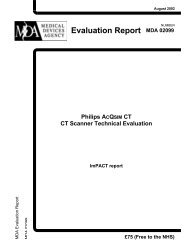view presentation - ImPACT CT Scanner Evaluation Centre
view presentation - ImPACT CT Scanner Evaluation Centre
view presentation - ImPACT CT Scanner Evaluation Centre
- No tags were found...
Create successful ePaper yourself
Turn your PDF publications into a flip-book with our unique Google optimized e-Paper software.
Low contrast detail detectability measurementson multi-slice <strong>CT</strong> scannersNicholas Keat, Sue Edyvean<strong>ImPA<strong>CT</strong></strong> GroupLondon, UKwww.impactscan.orgRSNA 2003
Clinical importance of low contrast detectability• Studies where soft tissue differentiation is important arecommon in <strong>CT</strong>•Abdomen, Pelvis 26 %•Cerebrum 22 %•Spine 20 %•Mediastinum 7 %•Lung parenchyma 6 %•Trauma 5 %•Interventions 4 %•Base of skull 3 %•Pediatrics 3 %•Orthopedics 3 %•Inner ear 1 %Contrast resolution moreimportant in ~90 %Spatial resolution moreimportant in ~10 %RSNA 2003Typical case breakdown for a UK general hospital
Assessment of LCD• Usually use uniform phantoms with variable size lowcontrast inserts• Catphan was used in this study• All vendors quote scanner performance on this phantom0.3% (3 HU)contrast0.5% (5 HU)contrast1.0% (10 HU )contrastRSNA 2003Catphan 500Details 2-15 mm diameter
<strong>Scanner</strong>s’ stated performance<strong>Scanner</strong>PhantomContrastSlice widthSurface DoseDetail SizeDetail visibilitycriteria• Data not directly comparableGE Philips Siemens ToshibaLightSpeed + Mx8000 Volume Zoom Aquilion MultiCatphan Catphan Catphan Catphan0.3% 0.3% 0.3% 0.3%2 x 10 mm 10 mm 1 x 10 mm 10 mm18 mGy 27 mGy 21 mGy 120 kV, 150 mAs*5 mm 4 mm 5 mm 4 mm? ? ? ?*<strong>ImPA<strong>CT</strong></strong> estimated <strong>CT</strong>DI: 24 mGyRSNA 2003Source: <strong>ImPA<strong>CT</strong></strong> Four Slice <strong>CT</strong> <strong>Scanner</strong> Comparison Report, V5
Standard LCD assessment conditions• In order to provide more comparable results, standardexposure and reconstruction parameters were used– 120kV, 10 mm image*, 20 mm collimation*, 25 mGysurface dose, 20 images– Standard kernel, 25 cm FOV, no bone correction wherepossible• Images scored by four observers under standard conditionswith written visibility criteria– All images <strong>view</strong>ed in a single session in random order– 0.3 % contrast (3 HU) details scoredRSNA 2003* Closest available setting used, corrections made where necessary
Image scoring• Images scored for smallest visible detail using customwritten IDL programRSNA 2003
Result <strong>presentation</strong>• Percentage of images at each detail size that is visible isplotted (20 images)– e.g. 15 mm detail visible in 18 images: 90 % visibility– 7 mm detail visible in 10 images: 50 % visibility100%90%80%70%RSNA 2003Visibility (%)60%50%40%30%20%10%0%Better LCD up andtowards left0 1 2 3 4 5 6 7 8 9 10 11 12 13 14 15Detail diameter (mm)
Results: Inter-<strong>view</strong>er variability• Four <strong>view</strong>ers for single group of 20 images– e.g. for > 50% visibility, results vary between 5 and 7 mm100%90%80%70%Visibility (%)60%50%40%30%RSNA 200320%10%0%0 1 2 3 4 5 6 7 8 9 10 11 12 13 14 15Detail Diameter (mm)
Results for 16 slice scanners100%90%80%70%Visibility (%)60%50%40%30%20%10%0%GE LightSpeed16Philips Mx8000IDTSiemens Sensation 16Toshiba Aquilion 160 1 2 3 4 5 6 7 8 9 10 11 12 13 14 15Detail Diameter (mm)RSNA 2003Bars show range of results from four assessors
Results for 4 slice scanners100%90%80%70%Visibility (%)60%50%40%30%20%10%0%GE LightSpeed PlusPhilips Mx8000Siemens Sensation 4Toshiba Aquilion Multi0 1 2 3 4 5 6 7 8 9 10 11 12 13 14 15Detail Diameter (mm)RSNA 2003Bars show range of results from four assessors
Result variability: 4 slice scanners• Four <strong>view</strong>ers assessing 80 images (20 from 4 scanners)– Complete agreement of all four <strong>view</strong>ers for 6 images(7.5%)– Standard deviation from mean score for each image was1.1 detailsRSNA 2003
Results: Intra-<strong>view</strong>er variability• Single <strong>view</strong>er, assessing same group of 20 images on 5occasions (> 1 month apart)– For > 50% visibility, results vary between 5 and 8 mm100%90%80%70%Visibility (%)60%50%40%30%20%10%0%1st Reading2nd Reading3rd Reading4th Reading5th reading0 1 2 3 4 5 6 7 8 9 10 11 12 13 14 15Detail Diameter (mm)RSNA 2003
Result variability: single set of images• Single <strong>view</strong>er assessing 20 images <strong>view</strong>ed 5 times– Complete agreement for 0 images– Standard deviation from mean score for each image was1.4 detailsRSNA 2003
LCD and dose• Single <strong>view</strong>er, looking at images acquired at different dose(mAs) levels at the phantom surface– Expected improvement in visibility is seen at higher doseVisibility (%)100%90%80%70%60%50%40%30%10 mGy15 mGy20 mGy25 mGy30 mGy35 mGyRSNA 200320%10%0%0 1 2 3 4 5 6 7 8 9 10 11 12 13 14 15Detail Diameter (mm)
Conclusions• Definitive assessment of LCD made difficult by inherentsubjectivity and <strong>view</strong>er variability• Comparisons of results from separate image <strong>view</strong>ingsessions will lead to inconsistency• Within a single <strong>view</strong>ing session, results can be compared– Surface dose differences of 5 mGy were differentiated• Differences in Catphan LCD performance of 4 and 16 slicescanners under these conditions are small, and the range ofresults for scanners overlap• There is a difference between the clinical tasks of diagnosisin <strong>CT</strong> and the assessment of circular, well defined objectswith a priori knowledge of their position and sizeRSNA 2003Slides available at www.impactscan.org














